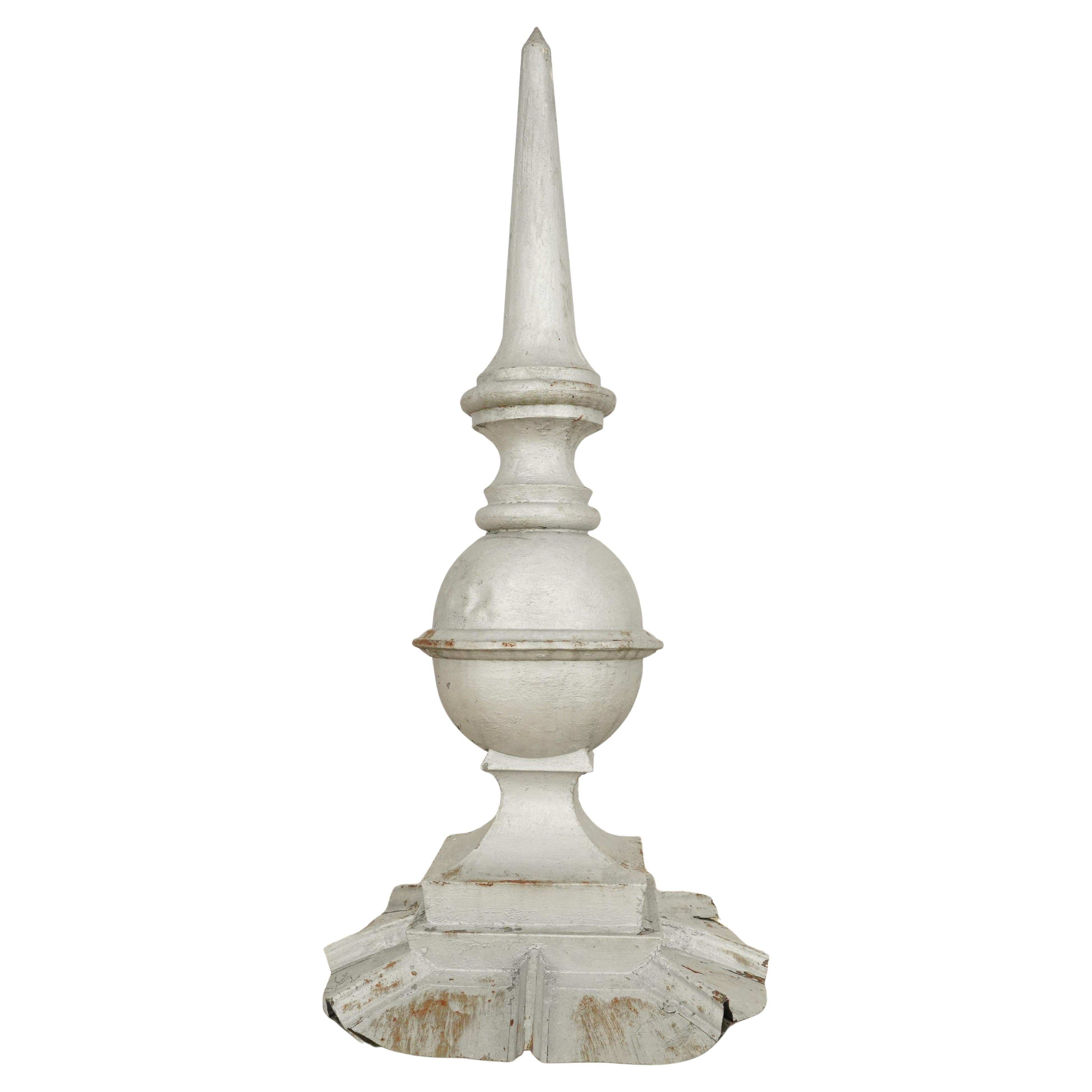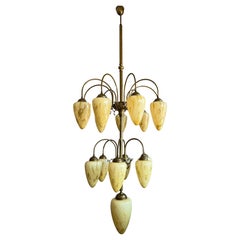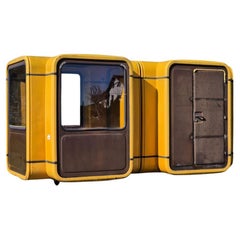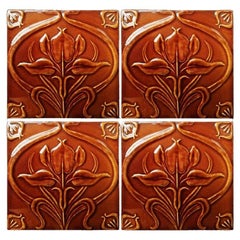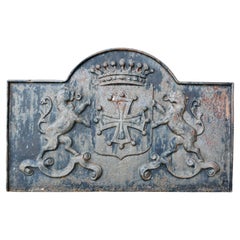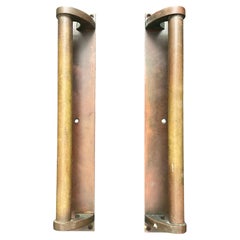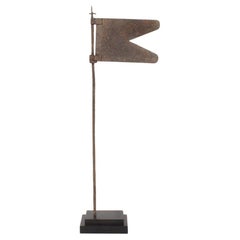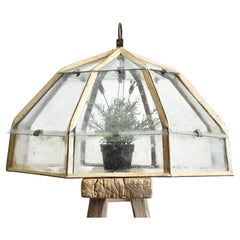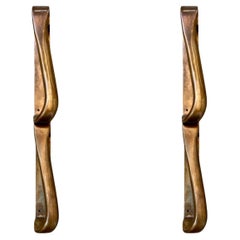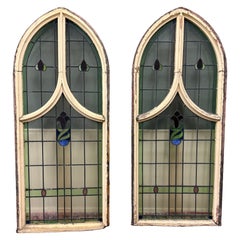Architectural Elements
to
476
2,018
1,623
3,313
377
48
Height
to
Width
to
246
186
138
136
124
108
105
103
89
84
83
66
49
40
36
13
12
5
735
1,328
1,250
425
413
408
246
47
11
87
61
29
75
84
94
18
21
1,276
1,256
955
628
466
2,489
896
589
554
525
3,738
3,508
3,628
59
34
24
20
17
Architectural Elements For Sale
Huge 9 Feet High, Art Deco Style Brass and 16x Marbled Glass Chandelier Pendant
Located in Lisse, NL
Enormous Mid-Century Modern Brass & Handblown Glass Chandelier, Art Deco Style, 1950s.
A breathtaking and rare monumental chandelier from the 1950s, masterfully handcrafted with tim...
Category
Mid-20th Century Dutch Mid-Century Modern Architectural Elements
Materials
Brass
Set of Two Long Push and Pull Door Handles, England
Located in London, GB
A pair of bronze door handles, each with a long rectangular mounting plate. First half twentieth century, found in England.
The handles are a very simple design, made from bronze (o...
Category
20th Century English Art Deco Architectural Elements
Materials
Bronze
French, 17th/ 18th Century, Forged Iron Weathervane
Located in Buisson, FR
Unique hand forged iron weathervane. Beautiful eyecatcher, France, circa 1650-1750. Weathered. Measurement here below is inclusive the wooden base.
H:74cm W:32cm D:11,5cm
Category
17th Century French French Provincial Antique Architectural Elements
Materials
Iron
$692 Sale Price
41% Off
Antique Victorian French Country House Iron & Glass Garden Cloche
Located in Stockbridge, GB
Antique Lantern Cloche – C
A stunning octagonal lantern cloche, salvaged from France. The cloche creates a miniature greenhouse and provides a beautiful form of protection of plants...
Category
Early 20th Century French French Provincial Architectural Elements
Materials
Steel
Alvar Aalto Bronze Door Hardware / Pulls, Set of 4
By Alvar Aalto
Located in Round Top, TX
Alvar Aalto originally designed this door handle for the National Pensions Institute in Helsinki (1948-57) and, because it was such a successful form, reused in on many of his subseq...
Category
Early 20th Century Italian Organic Modern Architectural Elements
Materials
Bronze
$20,000 / set
Antique English PAIR LARGE GOTHIC CHURCH Stained Glass Windows Leaded Framed
Located in Tyler, TX
GORGEOUS Antique English LARGE Pair of GOTHIC Wood-Framed Leaded, Stained Glass Windows
Beautiful LARGE matching PAIR of antique English leaded stained-glass windows ~~red, green, ...
Category
Early 1900s English Gothic Antique Architectural Elements
Materials
Glass, Oak
Italian 16th/17th Century Small Iron Door Depicting Saint George
Located in Buisson, FR
Amazing period piece.
Beautiful small iron door that most likely once had its place in an Italian Chapel.
It is depicting Saint George killing the dragon. Beautiful naive style.
Ital...
Category
17th Century Italian Antique Architectural Elements
Materials
Iron
$2,947 Sale Price
38% Off
Alvar Aalto Sculptural Door Handles / Pulls in Cast Bronze, Valaistustyö 1950s
Located in Helsinki, FI
Two sleek, heavy and elegant mid-century door handles in full bronze. Manufactured by valaistustyö and designed by Alvar Aalto himself. Very practical yet stand out as sculptural pie...
Category
1950s Finnish Mid-Century Modern Vintage Architectural Elements
Materials
Bronze
Japanese Matching Set of Two Fine Birds And Dragonfly Shoji Doors Screens
Located in South Burlington, VT
Japan, a fine set of two shoji "Birds and Dragonfly" bamboo doors or screens recently acquired from a Japanese private collector. The hand carved boards are artistically cut and ins...
Category
Early 20th Century Japanese Taisho Architectural Elements
Materials
Bamboo, Wood
16th Century Italian Pair of Antique Corinthian Capitals
Located in West Palm Beach, FL
An antique Italian pair of Corinthian Capitals from the Renaissance period, hand carved in limestone. Minor fading, scratches due to age. Wear consistent with age and use. Circa 1500...
Category
16th Century Italian Renaissance Antique Architectural Elements
Materials
Limestone
Large Royal Coat of Arms Hand Painted on Wood
Located in Douglas Manor, NY
5099 English heroldry wall panel .
Hand painted Oil on wood
Latin Inscribed "Dieu Et Mon Droit" God and My Right
Category
1950s Vintage Architectural Elements
Materials
Plywood, Paint
Pair 19th Century, French Zinc Mythical Lion- Wolf Head Fragments
Located in Buisson, FR
Beautiful and rare decorative zinc item that once graced a facade, France, circa 1850-1900
Weathered and small losses but despite of its age in a good condition
Measurement here belo...
Category
19th Century French Antique Architectural Elements
Materials
Zinc
$691 Sale Price / set
41% Off
Antique European Encaustic Cement Tiles. Pre-WWII
Located in Baltimore, MD
Encaustic cement tiles were pioneered by the French in the middle of the 19th century and relied on chemical curing rather than traditional firing. This technique had the advantage ...
Category
1930s European Vintage Architectural Elements
Materials
Cement
Brutalist Aluminium Door Panel with Antique Bronze Finish
Located in London, GB
A Brutalist aluminium door panel with integrated handle and bronzed patina. Second half 20th century, found in Belgium.
A sculptural piece, unsigned, reminiscent of the style of Bil...
Category
Late 20th Century Belgian Brutalist Architectural Elements
Materials
Aluminum
Facade panel by Jean Prouvé, circa 1960, Lyon France
By Jean Prouvé
Located in VILLEURBANNE, FR
Just a stone’s throw from our office stands the campus of La Doua in Villeurbanne — a major site of French modernist architecture. While much of the university has been renovated ove...
Category
Mid-20th Century Cameroonian Mid-Century Modern Architectural Elements
Materials
Aluminum
$2,800 / item
French 18/19th Century, Carved White Marble Neoclassical Capital
Located in Buisson, FR
Beautiful hand-carved white marble capital .
Beautiful weathered white marble .
France circa 1780- 1820
Weathered
H:17cm W:18cm D:18cm
Category
18th Century French Neoclassical Antique Architectural Elements
Materials
Marble
$811 Sale Price
47% Off
Bronze Pull Handles for Drawers and Cabinets
Located in London, GB
Bronze pull handles are suitable for drawers, cupboards and any type of cabinet furniture,. The design is inspired by vintage leather handles on suitcases with a textured surface bu...
Category
1970s German Vintage Architectural Elements
Materials
Bronze
18th C. Italian Carved Giltwood Pediment Architectural Fragment Wall Hanging
Located in Pearland, TX
A gorgeous 18th-Century Italian gilt wood gold leaf over door pediment / architectural fragment / wall swag / hanging wall ornament. This stunning architectural element has lovely ca...
Category
18th Century Italian Rococo Antique Architectural Elements
Materials
Giltwood
Fireplace Screen in Metal with a Blackened Steel Finish Customizable
By Redsoul
Located in Seattle, WA
The Court Screen is a modern metal fireplace screen cover that can be used flush fitted into the fireplace opening or can stand right outside a ...
Category
2010s American Industrial Architectural Elements
Materials
Steel
Japanese Huge Antique Stone Pagoda Lantern 180 Inches- Exceptional Garden Art
Located in South Burlington, VT
Just discovered from an old Kyoto garden- impressive garden Sculpture, 15 Feet Tall
Message or Call us for details or to reserve...
For the finest garden- a spiritual representation of five earthly and celestial elements.
Japan, a monumental antique stone pagoda tower that is nearly five meters , about 180” tall,
hand carved from solid granite, Taisho period circa 1920s, and a spiritual representation of five earthly and celestial elements.
This pagoda rivals a similar example given by Sapporo, Japan to the Portland, Oregon Japanese garden (See Portland's Japanese Garden Pagoda...
Category
Early 20th Century Japanese Taisho Architectural Elements
Materials
Granite
Square Bronze Push-Pull Door Handle with Raised Abstract Design
Located in London, GB
A square push-pull door handle with raised abstract design made of cast bronze. Mid to late 20th century, found in Germany.
A nice heavy piece with a dark applied patina. There are ...
Category
20th Century German Mid-Century Modern Architectural Elements
Materials
Bronze
1930s Corrugated 27 3/4 x 47 3/4 Clear Chicken Wire Glass
Located in New York, NY
Reclaimed from old warehouses and industrial buildings, this clear corrugated industrial glass was used as exterior awnings or partitions indoors and out. Measures 27.75 wide x 47.75...
Category
1930s American Industrial Vintage Architectural Elements
Materials
Glass
Antique & Large Hand-Forged Wrought Iron Art Nouveau Gazebo or Garden Gloriette
Located in Lisse, NL
Very rare, hand forged, wrought iron, architectural garden pergola.
If you appreciate the time, the effort and the quality of the workmanship that early 20th century craftsman put i...
Category
Early 20th Century European Arts and Crafts Architectural Elements
Materials
Wrought Iron
Entrance or Passage Way Large Double Door Starburst Hardware Kit
Located in South Charleston, WV
Produced for doors from 56" to 78" wide and from 79" to 120". All doors exceeding 96" will be custom quoted. See our other listings for custom doors and single door kits also.
Brass or Stainless Steel. Brass is warrantied for 1 year with a finish applied and is for interior use. You can request "living finish" for brass with no coating that will patina with age and use for interior or exteriors. Stainless Steel can be used on interiors or exteriors and has a natural finish that will last decades, but is warrantied for 5 years.
In 2015 we started building the modern Mid-Century Modern sunburst door reimagined with solid brass bars or stainless steel. We are now offering a hardware door kit that will allow you to install these modernist bars on any interior or exterior flush...
Category
2010s American Mid-Century Modern Architectural Elements
Materials
Brass, Stainless Steel
Handmade 21st Century Resin Hardware Large Knob in Tortoise by Elyse Graham
By Elyse Graham
Located in Springfield, OR
Our signature experimental resin casting is now available as hardware for any cabinet, drawer, or door. Each resin piece we make is non-repeating and completely individual. We have ...
Category
2010s American Organic Modern Architectural Elements
Materials
Stainless Steel
Rare France Limoges Porcelain & Bronze Bathroom Set Washbasin Mirror Pendant Etc
By Limoges
Located in Lisse, NL
Highly decorative porcelain bathroom set with stunning roses pattern, by one of Europe's finest.
Over the years we have sold very few porcelain Limoges pieces and that is simply because these high value items don't find there way to the open market very often. So to have been given the opportunity to purchase a set as complete and remarkable as the one we are offering you here, more than made our day. Also, because we already know that someone will be thrilled to be able to own and use this rare and beautiful set in their (new) home or, for example, in their holiday home. This vintage Limoges set of high quality and detail consists of the following:
- A practical size washbasin with gilt bronze mythological dolphin handles.
- Large mirror in stylish bronze frame with a mounted (or built-in) 4-light sconce.
- A porcelain shelf (for wall mounting) to go under the mirror.
- A bronze and porcelain, 4 light pendant light.
- A shell design porcelain and bronze soap holder (for wall mounting).
- A toilet paper holder with some damage (we therefor listed this set as a five-piece set).
The two stunning bronze dolphins used to be the handles with which you could turn on the cold and hot water, but at some point in time the actual water tap...
Category
Mid-20th Century French Mid-Century Modern Architectural Elements
Materials
Bronze
English 19th Century Pair of Barley Twist Columns
Located in Baton Rouge, LA
This pair of English 19th century barley twist columns are a wonderful architectural antique to add an extra level of authenticity to your interior...
Category
19th Century English Other Antique Architectural Elements
Materials
Wood, Hardwood
Entrance or Passage Way Large Single Door Starburst Hardware Kit
Located in South Charleston, WV
Produced for doors from 24" to 50" wide and from 79" to 120". All doors exceeding 96" will be custom quoted. See other listings for custom doors and double door kits also.
Brass or ...
Category
2010s American Mid-Century Modern Architectural Elements
Materials
Brass, Stainless Steel
Brown and Yellow Art Nouveau Glazed Relief Tiles by Gilliot, Hemiksem, circa 192
By Gilliot
Located in Rijssen, NL
Handmade relief tiles in warm brown and yellow glazed colors. Manufactured around 1920 by Gilliot Hemiksem, Belgium.
These tiles would be charming displayed on easels, framed or inco...
Category
1920s Belgian Art Deco Vintage Architectural Elements
Materials
Ceramic
Vintage Dutch Delft Blue and White Tile Featuring a Heraldic Coat of Arms
By Delft
Located in Elkhart, IN
A beautiful hand painted blue and white Delft or French Provincial style ceramic tile featuring a stylized knight's armor and helmet, with a rhinoceros above a shield with two unicor...
Category
Late 20th Century Dutch Country Architectural Elements
Materials
Ceramic
Black Basketball Backboard, Rim and Chain
Located in Portland, OR
Solid blackened oak backboard with powder coated hoop and chain. Regulation size, though can be made to custom dimensions or with other wood species. Comes with wall mounting bracket...
Category
21st Century and Contemporary American Modern Architectural Elements
Materials
Oak
$2,100 / item
Antique English Sterling Silver Brick Layers Trowel Bone Handle Henry Wilkinson
Located in Dublin, Ireland
Stunning Example of a Traditional Brick Layers Heavy Duty Sterling Silver Trowel, complete with its original hand carved bone handle. Last quarter of the Nineteenth Century, dated 18...
Category
Late 19th Century British Victorian Antique Architectural Elements
Materials
Sterling Silver
Bronze Push-Pull Handle with Abstract Modernist Design, 20th Century
Located in London, GB
An unusual square push-pull door handle made of patinated bronze featuring a raised modernist design of overlapping loosely geometric shapes. 20th century design, found in Germany.
...
Category
20th Century German Mid-Century Modern Architectural Elements
Materials
Bronze
19th Century French Pair of Antique Pinewood Garden Treillis Obelisks
Located in West Palm Beach, FL
An antique pair of tall treillis obelisks in Versailles green topped by pointed finials, in good condition. These antique hand crafted painted Pinewood obelisks have multiple layers ...
Category
19th Century French French Provincial Antique Architectural Elements
Materials
Pine
Japanese Fine Pair Arts And Crafts Shoji Door Screens
Located in South Burlington, VT
Japan, a fine pair of two simple shoji bamboo doors or screens creating an arts and crafts look. The pair are hinged together for convenient display with attractive portals above; ...
Category
Early 20th Century Japanese Showa Architectural Elements
Materials
Bamboo, Wood
Entrance or Passage Way Large Starburst Door Hardware Kit
Located in South Charleston, WV
Aaron Saxton for History Never Repeats.
We have 2 listings for either single or double doors. This listing is for the single door pattern. We produce the kit for doors up to 50" wide and 120" in height, with kits over 96" tall being Price On Request. The last image showing a double white door is an example of a customer who has installed our starburst kit for reference.
In 2015 we started building the modern Mid-Century Modern starburst door...
Category
2010s American Mid-Century Modern Architectural Elements
Materials
Brass, Stainless Steel
Jean Prouvé Mid Century "CIMT" Aluminum Facade Panel Produced in France, 1950s
By Jean Prouvé
Located in Stockholm, SE
Rare mid century aluminum "CIMT" facade panel by Jean Prouvé for Campus Scientifique De La Doua in Lyon, France 1950s. In good vintage and original condition.
Dimensions: H: 170 cm...
Category
1950s French Mid-Century Modern Vintage Architectural Elements
Materials
Aluminum
Circular Push-Pull Door Handle in Bronze, Mid-20th Century, France
Located in London, GB
Circular push-pull door handle in bronze (or brass), mid-20th century, France.
A very simple elegant handle, made up of two separate pieces - each side with a slightly concave dish ...
Category
Mid-20th Century French Mid-Century Modern Architectural Elements
Materials
Bronze
Three Delft Ceramic Wall Tiles Blue & White figures Hand Painted, Circa. 1800
Located in Lincoln, Lincolnshire
These are a very decorative set of Three small ceramic wall tiles, with a Blue and White figural scene, dating to the later part of the 18th century or early in the 19th Century.
Al...
Category
Early 19th Century Dutch Dutch Colonial Antique Architectural Elements
Materials
Ceramic
Pair of Large Architectural Iron Wall Hanging
Located in Delray Beach, FL
One of a kind pair of wrought iron wall hanging artistically forged ,hand painted ,could hang horizontal or vertical.
Category
20th Century Unknown Architectural Elements
Materials
Wrought Iron
Antique Italian Tri-Color Stain Glass Windows
Located in Dallas, TX
These antique Italian tri-color stained glass windows are a beautiful and unique addition to any home or building. The geometric designs and muted colors add a touch of elegance to a...
Category
Early 20th Century Italian Architectural Elements
Materials
Metal
$10,800 / set
One of a Kind Large Hand Painted Ceramic Tile Mirror
Located in Delray Beach, FL
Beautiful large mirror made of hand-painted and glazed ceramic tiles, with exceptional motifs of vines flowers fish and birds. Great object of art for wall display.
Total weight : 6...
Category
21st Century and Contemporary North American Architectural Elements
Materials
Ceramic, Wood
Vintage Dutch Delft Blue and White Tile Featuring a Boy and Cart
By Delft
Located in Elkhart, IN
A beautiful hand painted blue and white Delft or French Provincial style ceramic tile featuring a boy pushing a cart. This would make an excellent coaster.
Holland, Circa Late-20th ...
Category
Late 20th Century Dutch Country Architectural Elements
Materials
Delft
American 19th c. Cast Iron Sink on Original Legs
By Fiske Or Mott
Located in New York, NY
Rustic, Farmhouse style cast iron sink on original cast iron legs. Structurally sound, and sturdy, showing allover rust surface, normal and consistent with age.
Originally designed...
Category
19th Century American Rustic Antique Architectural Elements
Materials
Iron
18th Century Italian Frieze Carved Painted Wall Panel #1
Located in Bradenton, FL
18th century Italian wall decorative panel frieze with stunning hand-carved gilded relief. The decorative gilt relief motif is very classical, hand-carved with alternating love knots...
Category
18th Century Italian Renaissance Antique Architectural Elements
Materials
Wood
Antique Stone Neoclassical Ionic Column Capital Stand, 19th Century
Located in Elkhart, IN
A stunning Greek or Roman Neoclassical style cast stone Ionic column capital. This piece of architectural salvage would make a lovely objet d'art, ...
Category
Late 19th Century American Neoclassical Antique Architectural Elements
Materials
Cast Stone
$1,036 Sale Price
20% Off
Early 20th Century Wrought Iron and Brass French Bakers Rack Wrought
Located in New York, NY
Charming French Bakers Rack constructed of wrought iron and cast brass. This example features decorative wrought scroll work, with strong cast brass decorative elements. It has three...
Category
Early 20th Century French Romantic Architectural Elements
Materials
Brass, Wrought Iron
Alvar Aalto Sculptural Door Handles/Pulls in Cast Bronze, Valaistustyö 1950s
Located in Helsinki, FI
Two sleek, heavy and elegant mid-century door handles in full bronze. Manufactured by valaistustyö and designed by Alvar Aalto himself. Very practical yet stand out as sculptural pie...
Category
1950s Finnish Mid-Century Modern Vintage Architectural Elements
Materials
Bronze
Reclaimed French Rustic Style Limestone Architectural Element
Located in Beervelde, BE
An original antique burgundy hard stone bloc with a central lower part. Perfect to be used as a tabletop or for a Wabi Sabi spirit fireplace base and ca...
Category
16th Century French Antique Architectural Elements
Materials
Limestone
Frank Lloyd Wright Custom Slant Arm Origami Chair for Price Tower 1956
Located in Dallas, TX
One of only forty examples ever created, this slant arm chair was designed in 1956 by Frank Lloyd Wright for the Price Tower and is often referred to as the "origami chair". The inno...
Category
1950s American Mid-Century Modern Vintage Architectural Elements
Materials
Aluminum
17th/ 18th Century Italian Baroque Marble Holy Water Font or Stoup
Located in Buisson, FR
Beautiful Baroque marble holy water font or stoup,
Unique and original period piece. Italy, circa 1650-1750. Weathered condition.
H:8cm W:24,5cm D:21-31cm
Category
17th Century Italian Baroque Antique Architectural Elements
Materials
Marble
$956 Sale Price
57% Off
15th C Gothic Tabernacle 4 ft.+ Rare Architectural Religious Art, Museum Quality
Located in Vero Beach, FL
15th century period Gothic Tabernacle, extremely rare (Medieval) architectural religious art, museum quality ecclesiastical altar piece.
This is an ...
Category
15th Century and Earlier German Medieval Antique Architectural Elements
Materials
Wood, Paint
$16,000 Sale Price
50% Off
Frank Lloyd Wright 1979 Plaster Cast Tree of Life
Located in Palm Springs, CA
Licensed and manufactured by the Frank Lloyd Wright Home & Studio Foundation in 1979, this large Plaster Bas-Relief Plaque is an exact replica of the original, which adorned the entr...
Category
1970s American Vintage Architectural Elements
Materials
Plaster
WWII Era U.S. Navy Cast Iron Ship Bell with Bracket
Located in Doylestown, PA
WWII era classic Navy ship's bell cast in iron with raised lettering, "U.S.N." The bell features all its original components with a bracket for hanging. Bells during this period were...
Category
1940s American Vintage Architectural Elements
Materials
Iron
Mid-Victorian Moorish wrought & cast iron pergola or decorative garden structure
Located in London, GB
A monumental Moorish mid-Victorian wrought iron Pergola or Decorative Garden Structure, a unique masterpiece in High Victorian Ironwork design. Ou...
Category
Late 19th Century European Moorish Antique Architectural Elements
Materials
Wrought Iron
Antique Limestone Fireplace Mantel from France
Located in Haarlem, Noord-Holland
Nice French Campagnard style fireplace mantel in lovely limestone.
This gem comes from central France, burgundy area.
Its perfect size make it possible to install this mantel in almo...
Category
19th Century French Antique Architectural Elements
Materials
Limestone
Pair of Wrought Iron Screens with Floral Patterns, early 20th Century, European
Located in London, GB
A set of two very attractive wrought iron screens depicting flowers and stylised leaves. European, early years of the twentieth century, possibly German or Czech in art nouveau or ea...
Category
Early 20th Century German Art Nouveau Architectural Elements
Materials
Wrought Iron
Antique Fireplace Mantel Chimneypiece
Located in Made, NL
This antique fireplace is a rare piece in Breche Médicis marble, crafted in the 19th century.
It features an elegant design in the Louis XVI style and comes with its original cast ir...
Category
19th Century French Louis XVI Antique Architectural Elements
Materials
Marble
19c Antique Copper Brass Coal Scuttle Umbrella Stand Holder Netherlands
Located in St.Petersburg, FL
Handsome, hand wrought, industrial 19th Century Dutch Copper and Brass Coal Scuttle referred to as. "5KAN. This scuttle was used to carry coal or water. It has been elegantly repurp...
Category
19th Century Dutch Industrial Antique Architectural Elements
Materials
Brass, Copper
20th Century French Limestone Louis XV Fireplace Mantel
Located in Haarlem, Noord-Holland
Nice and clean French Louis XV fireplace mantel from the 20th century.
The lovely shell decorated frieze rests on solid jambs and supports a nice shaped and profiled top shelf.
Some...
Category
20th Century French Louis XV Architectural Elements
Materials
Limestone
